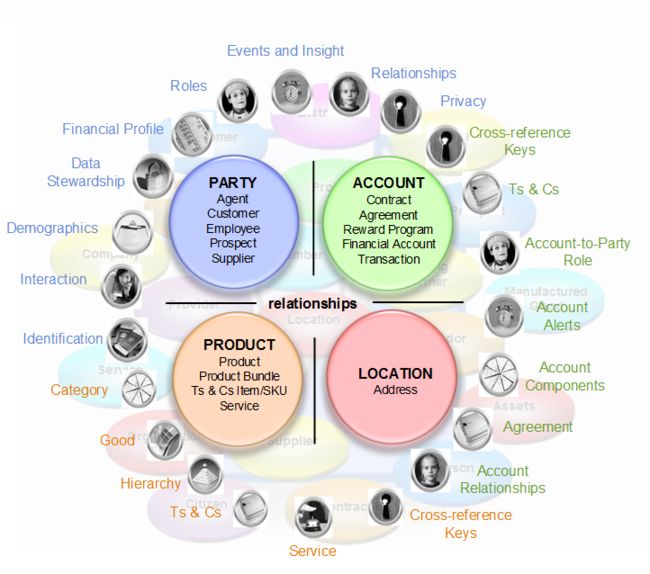Source: https://learn.ibm.com/course/...
What is Master data
Many entities can be mastered (as shown in the graphic), but many come together as the more generic “domains”: Party (customer, prospect, employee, supplier, agent, .etc.), Account (arrangement, contract, agreement, reward program, financial account, transaction, etc.) and Product (product, service, subscription, product bundle, Ts & Cs, Item/SKU, etc.).
What is MDM
MDM is:
- A Discipline that provides a consistent understanding of master data entities, and their relationships
- A set of Technologies that provides mechanisms for consistent use of master data across the organization, prescribed by governance policies
- A set of IT Practices and Processes designed to accommodate, control and manage change in your master data assets
Example:
To MDM, a rock is bumpy, gray and white, translucent, weighs 3 oz, has a diameter of 1 ½ inches and is made of quartz.
MDM and the business
Master Data Management helps answer questions about your master data. For example:
Are these two records the same person?
Does this person own multiple products or hold multiple accounts?
Are these two people related or share a household?
You need to have a good understanding of where your master data is and answer questions such as:
- Is it trustworthy, reliable, fresh?
- What systems, sources and processes contain master data? How do I distinguish them from those that don’t?
- How do I acquire that data, quickly, into a single 360-degree view, across customers, prospects, products, assets, locations, partners, employees, etc.?
- Beyond just accessing data, what quality issues are preventing data from providing meaningful insight into business processes?
- How do I keep my master data in synch across different processes and users?
The business drivers span four key areas: revenue growth, cost efficiency, agility, and regulatory compliance or risk management.
Business problems to solve
- Acquire, grow and retain customers
- Optimize operations; counter fraud and threats
- Maximize insight, ensure trust and improve IT economics
- Transform management processes
- Manage risk
- Create new business models
MDM solution
A master data management solution has the following key characteristics:
- Decouples master information from individual applications
- Becomes a central, application independent resource
- Simplifies ongoing integration tasks and new app development
- Ensure consistent master information across transactional and analytical systems
- Addresses key issues such as data quality and consistency proactively rather than “after the fact” in the data warehouse
MDM in Financial Services
In the Financial Services industry, MDM allows organizations to optimize up-sell and cross-sell processes, increase the efficiency of customer contact centers, detect fraud, and increase customer retention. MDM allows businesses in this industry to:
- Increase wallet share, provide better customer service and reduce costs through operational efficiencies
- Faster time to market with accelerated reviews/approvals
- Reduce risk and costs through operational efficiencies
- Provide better service with 360 view of customer’s banking products, history and applications
Example 1:
Business need:
The financial services group wanted a single, integrated view of its customers to ensure its marketing campaigns didn't encourage internal conflict between the brands and duplication of efforts, both of which had a negative effect on the bottom line.
Benefits:
- By creating a master data hub, using IBM MDM solution, 23 million source records were reduced to roughly 9 million unique accounts that contain all the data available for each customer in one place.
- Significantly increased market share without increasing marketing spend
- Saved approximately US$10 million annually on integration and associated costs
- Reduced direct mail and operational costs by eliminating duplicate mailings to the same households and elimination of redundant systems
Example 2:
Business need:
A bank has the classical industry classification code issue. Their government mandated that the new version of the industry classification code being used in their country to be in line with revised international standards.
Benefits:
- The bank is using IBM's Reference Data Management solution to govern the mapping between the two standards so that at a worldwide level, they can report on the industries of their customer base (i.e. what’s the top 3 industries of our customer base) even though different systems in different continents are tracking it using different conventions.
- Less time and cost to support new financial regulations
- Greater efficiency in updating, distributing and managing reference data
- Reduces risk in implementing an MDM initiative
MDM and service oriented architecture
Services are self-contained, reusable software modules each of which performs a specific business task. They have well-defined interfaces and are independent of the applications and the computing platforms on which they run.
A service-oriented architecture (SOA) can be described as a loose coupling of services which communicate with each other. The process of communication involves either simple data passing or it could involve two or more services coordinating some activity. Some means of connecting services to each other is needed.
Styles of MDM
Roles in an MDM Project
Implementation and Operations roles:
- Architect
- Database Administrator
- System Administrator
- Solution Developer
Enterprise Use of Master Data roles: - Business Analyst
- Business User
MDM-Powered Applications roles: - Application Developer
Governance (Data Stewardship) roles - Basic Data Steward
- Advanced Data Steward
- Data Steward Manager
- Master Data Governance Council








